How to Combat Social Media Cyberbullying
- Last Updated: July 14th, 2025

Attorney Jessie Paluch, founder of TruLaw, has over 25 years of experience as a personal injury and mass tort attorney, and previously worked as an international tax attorney at Deloitte. Jessie collaborates with attorneys nationwide — enabling her to share reliable, up-to-date legal information with our readers.
Legally Reviewed
This article has been written and reviewed for legal accuracy and clarity by the team of writers and legal experts at TruLawsuit Info and is as accurate as possible. This content should not be taken as legal advice from an attorney. If you would like to learn more about our owner and experienced injury lawyer, Jessie Paluch, you can do so here.
Fact-Checked
TruLawsuit Info does everything possible to make sure the information in this article is up to date and accurate. If you need specific legal advice about your case, contact our team by using the chat on the bottom of this page. This article should not be taken as advice from an attorney.
Key Takeaways:
- Cyberbullying on social media platforms can have devastating psychological and emotional consequences for victims, potentially leading to long-term mental health issues.
- Social media companies are crucial in combating cyberbullying by implementing effective reporting systems, moderating content, and collaborating with experts to develop solutions.
- Victims of cyberbullying have legal recourse, including reporting to law enforcement, seeking restraining orders, and pursuing damages.
Overview of Social Media Cyberbullying
On this page, we’ll discuss Social Media cyberbullying, strategies to prevent cyberbullying on social media, identifying signs of cyberbullying on Social Media, and much more.
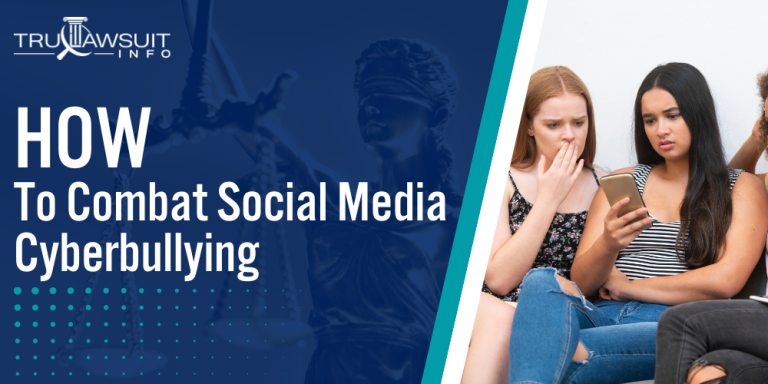
Intro to Social Media Cyberbullying
Some of the key aspects of Social Media Cyberbullying include, but are not limited to:
- Harassment and Intimidation: Cyberbullying involves the use of social media to harass, intimidate, or threaten others, often anonymously.
- Psychological Harm: Victims of cyberbullying can suffer from depression, anxiety, low self-esteem, and even suicidal thoughts.
- Platform Responsibility: Social media platforms are responsible for preventing and addressing cyberbullying on their platforms.
- Legal Remedies: Victims of cyberbullying may have legal options, such as filing a lawsuit against the bully or the social media platform.
If you or a loved one has been a victim of social media cyberbullying, it’s important to know that you have legal rights.
Contact TruLawsuit Info today using the chat on this page to receive an instant case evaluation.
Table of Contents
Understanding Cyberbullying on Social Media Platforms
Social media platforms offer connectivity and interaction but also present venues where cyberbullying can occur.
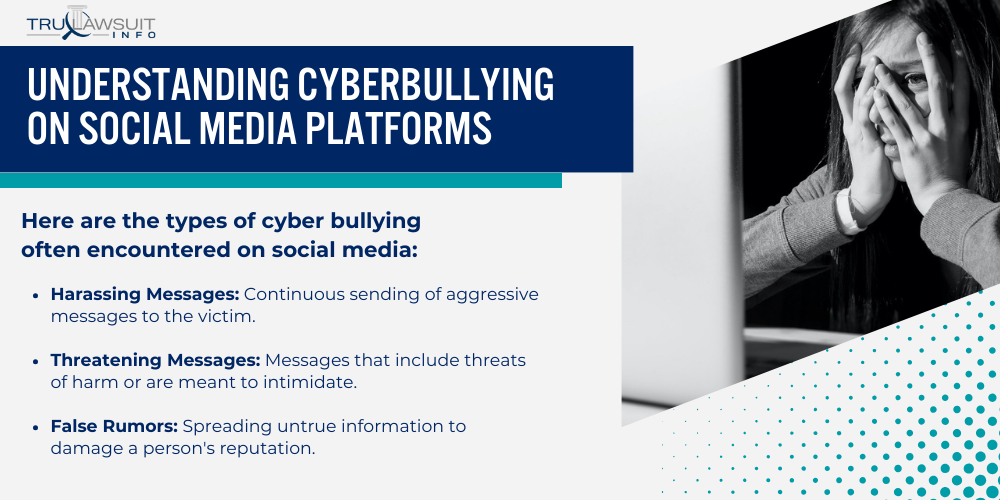
This section explores what cyberbullying entails and its common occurrence on these networks.
Definition and Types of Cyberbullying
Cyberbullying involves the use of electronic communication to bully a person, typically by sending messages of an intimidating or threatening nature.
Here are the types of cyber bullying often encountered on social media:
- Harassing Messages: Continuous sending of aggressive messages to the victim.
- Threatening Messages: Messages that include threats of harm or are meant to intimidate.
- False Rumors: Spreading untrue information to damage a person’s reputation.
- Explicit Images: Sharing private or sensitive images without consent.
Prevalence of Cyberbullying on Popular Social Networks
Cyberbullying has emerged as a disturbing trend on major social networking sites, affecting users worldwide.
While connecting millions, these digital environments also provide a platform for harmful interactions.
These platforms have become common grounds for such behaviors:
- Social Media Sites: They are where a vast majority of young people can be exposed to cyberbullying.
- Direct Messages: A feature misused to send harassing or threatening content.
- High School Students: A group often targeted and reporting to experience cyberbullying.
- School Districts: They are increasingly aware of cyberbullying incidents and strive to combat them.
Findings from the Pew Research Center indicate that a significant portion of U.S. teens have experienced cyberbullying.
The Impact of Social Media Cyberbullying on Victims
Social media cyberbullying can have devastating effects on the victims, leaving deep psychological scars and potentially lasting mental health issues.
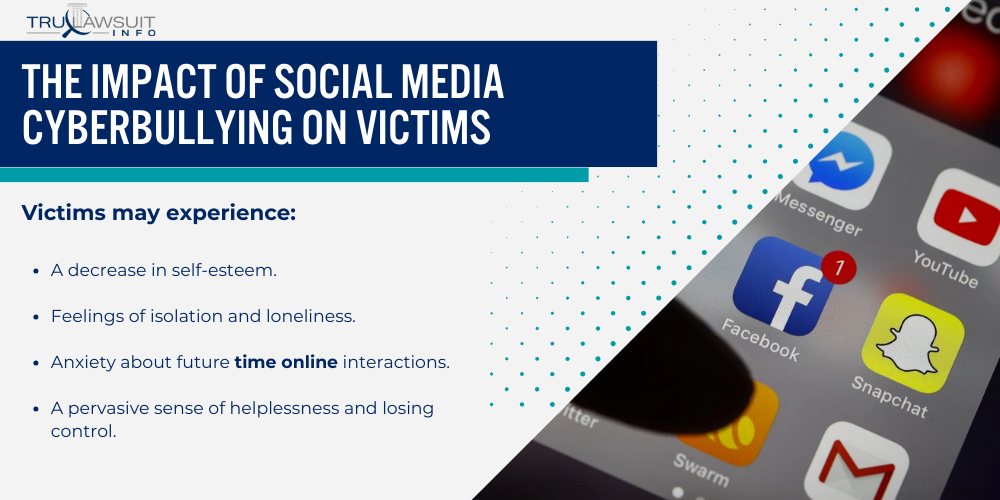
Psychological and Emotional Consequences
Cyberbullying on social media can lead to a range of psychological and emotional consequences for victims.
They often feel a barrage of negative emotions, including sadness, anger, and fear.
Victims may experience:
- A decrease in self-esteem.
- Feelings of isolation and loneliness.
- Anxiety about future time online interactions.
- A pervasive sense of helplessness and losing control.
These negative consequences are not just temporary; the emotional turmoil can disrupt their real life, affecting personal relationships and daily functioning.
Potential Long-Term Effects on Mental Health
The strain on mental health from cyberbullying can linger well into the future, potentially leading to more severe issues.
Some of the long-term effects may include:
- Chronic stress or anxiety disorders.
- An increased risk of depression.
- Difficulties with trust and forming new relationships.
- Sustained impact on academic performance, such as poor grades.
Victims may also explore potential legal recourse with their families to address the harassment.
However, despite the availability of legal paths, the psychological impact and the struggle for recovery can be arduous.
Identifying Signs of Cyberbullying on Social Media
It’s important to recognize the signs of cyberbullying on social media, as early intervention can help prevent further emotional harm.
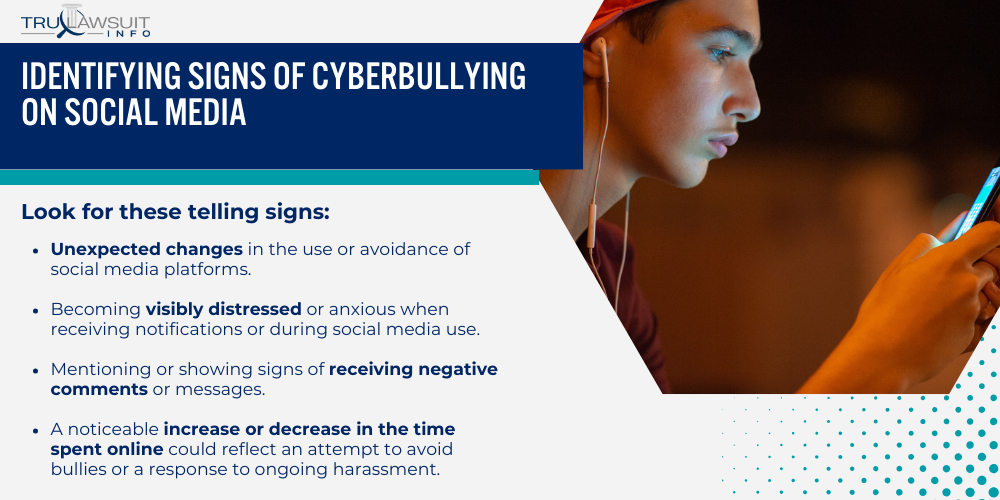
Being aware of changes in a person’s behavior and understanding the tactics used by cyberbullies are key steps in identifying and addressing the issue.
Changes in Behavior and Online Activity
Social media has become a prevalent platform where cyberbullying can occur, often noticeable through shifts in an individual’s behavior and online activity.
Look for these telling signs:
- Unexpected changes in the use or avoidance of social media platforms.
- Becoming visibly distressed or anxious when receiving notifications or during social media use.
- Mentioning or showing signs of receiving negative comments or messages.
- A noticeable increase or decrease in the time spent online could reflect an attempt to avoid bullies or a response to ongoing harassment.
Recognizing Common Tactics Used by Cyberbullies
Cyberbullies employ various methods to intimidate or harass others on social media.
Identifying these tactics can be critical in recognizing acts of cyberbullying:
- Spread of rumors or sharing false information to damage one’s reputation.
- Sending or posting threatening messages or physical threats that aim to instill fear.
- Engaging in public shaming or humiliation to exert power over the individual.
- Systematic campaigns to exclude individuals from social groups, challenging social norms and creating a hostile environment.
By understanding these behaviors and methods, individuals can be better equipped to identify and support those affected by cyberbullying on social media platforms.
Strategies to Prevent Social Media Cyberbullying
This section assesses the means of minimizing cyberbullying on social media platforms.
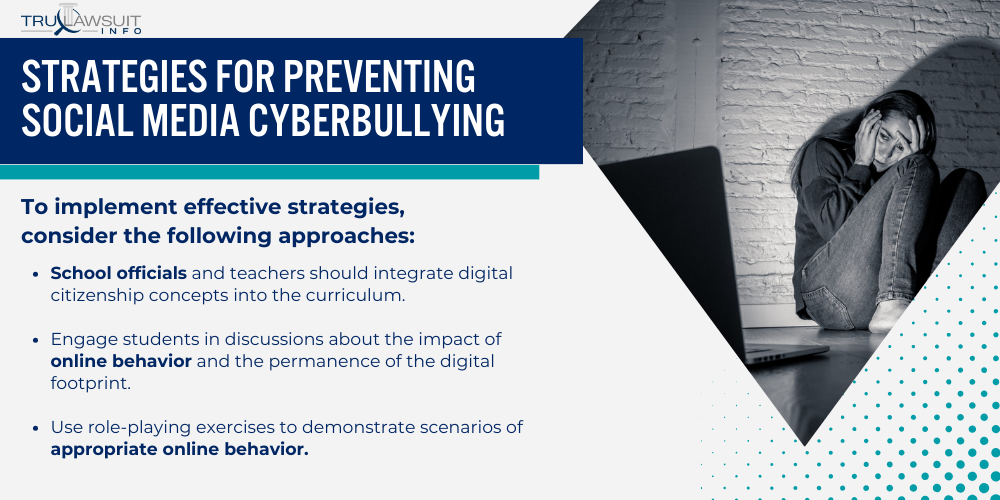
Effective strategies involve education on suitable online conduct and fostering support through open dialogue.
Educating Youth About Responsible Online Behavior
Education is a powerful tool in the fight against cyberbullying.
Schools and community organizations can help teach youth about the potential repercussions of their actions in the online world.
To implement effective strategies, consider the following approaches:
- School officials and teachers should integrate digital citizenship concepts into the curriculum.
- Engage students in discussions about the impact of online behavior and the permanence of the digital footprint.
- Use role-playing exercises to demonstrate scenarios of appropriate online behavior.
- Encourage and educate students to think critically about the content they share and how to address negative interactions online.
Encouraging Open Communication and Support Systems
Open communication with trusted adults can provide critical support to individuals experiencing cyberbullying.
To foster a supportive network, take these proactive steps:
- Instruct parents and guardians on recognizing the signs of cyberbullying and how to offer support.
- Create specific procedures for students to report instances of cyberbullying happen to school officials or community leaders.
- Create a safe space where youth can openly discuss online experiences and concerns.
- Encourage peer mentorship programs that reinforce positive online interactions and offer guidance on how to stop cyberbullying.
By promoting responsible online conduct and establishing supportive communities, it is possible to create a safer environment on social media and prevent cyberbullying.
Responding to Social Media Cyberbullying Incidents
When faced with social media cyberbullying, it’s important to take immediate and effective action to address the issue and mitigate its impact.
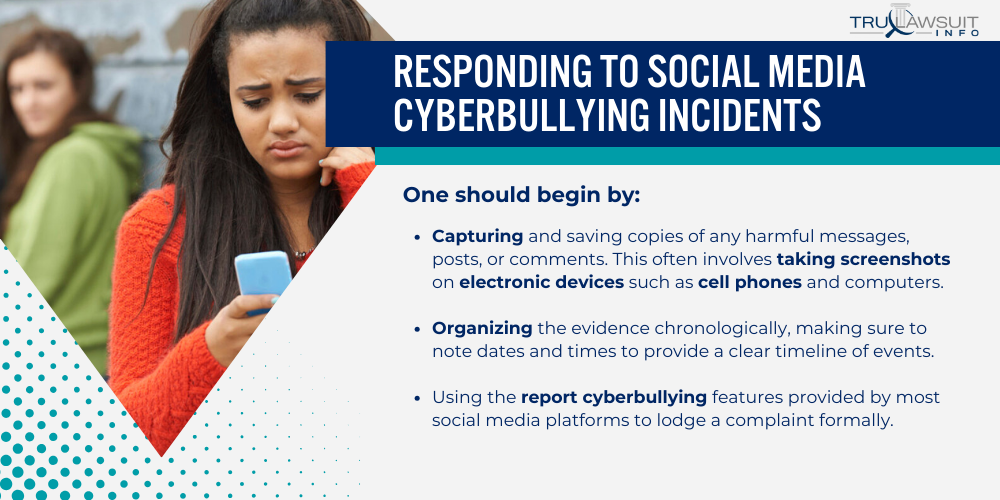
Documenting Evidence and Reporting to Authorities
Documentation is a pivotal step when dealing with cyberbullying.
One should begin by:
- Capturing and saving copies of any harmful messages, posts, or comments. This often involves taking screenshots on electronic devices such as cell phones and computers.
- Organizing the evidence chronologically, making sure to note dates and times to provide a clear timeline of events.
- Using the report cyberbullying features provided by most social media platforms to lodge a complaint formally.
- Contacting local authorities or cyberbullying agencies when the situation escalates or involves threats.
Evidence serves not only as a record but also as crucial support when authorities or social media platforms assess the situation.
Seeking Help from Trusted Adults and Professionals
When faced with cyberbullying, reaching out to trusted adults and professionals can provide essential support and guidance.
These individuals are crucial in addressing the issue and helping victims navigate their experiences safely and effectively.
It’s essential to involve supportive figures in the face of cyberbullying:
- Informing parents or guardians immediately, as they can offer support and assist in navigating the next steps.
- Reaching out to school officials if the cyberbullying involves peers or is affecting school life.
- Seeking counsel from mental health professionals to learn healthy ways to cope with the emotional stress brought on by cyberbullying.
- Considering support groups or community resources that specialize in assisting victims of cyberbullying.
This approach helps create a network of support that can guide one through the difficulties presented by cyberbullying on social media.
The Role of Social Media Platforms in Combating Cyberbullying
Social media platforms play a pivotal role in preventing and addressing cyberbullying.
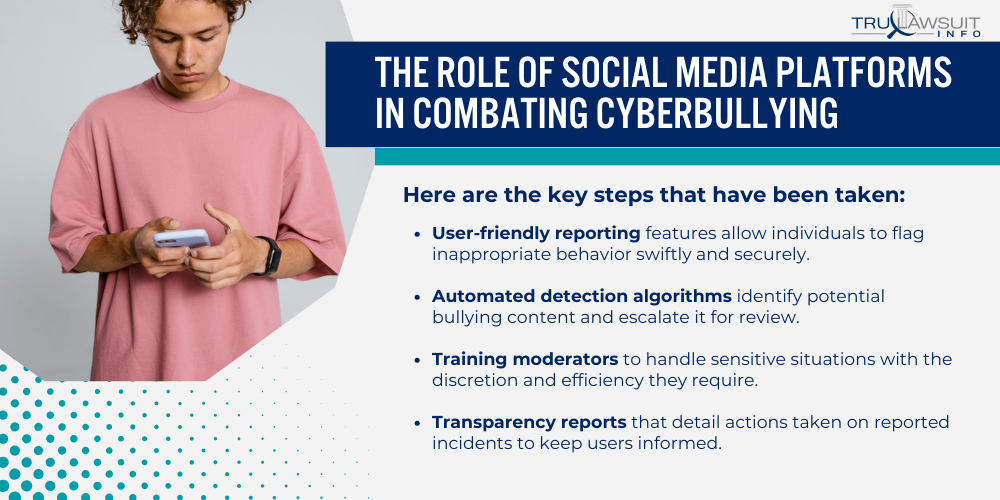
Their commitment to safety and community standards is essential in protecting users from harassment and abuse.
Implementing Effective Reporting and Moderation Systems
Social networking sites are in a unique position to monitor and mitigate cyberbullying through robust moderation tools.
Here are the key steps that have been taken:
- User-friendly reporting features allow individuals to flag inappropriate behavior swiftly and securely.
- Automated detection algorithms identify potential bullying content and escalate it for review.
- Training moderators to handle sensitive situations with the discretion and efficiency they require.
- Transparency reports that detail actions taken on reported incidents to keep users informed.
The creation and improvement of these systems reflect social media companies’ dedication to creating safer online environments.
Collaborating with Experts and Organizations to Develop Solutions
Collaborations between social media companies and external organizations are essential for creating innovative approaches to tackle bullying online.
Collaborative efforts include:
- Engaging with psychologists and sociologists to understand the impacts of cyberbullying.
- Joint ventures with non-profits that specialize in internet safety to educate users and policymakers.
- Sharing data with academic researchers to study the effectiveness of anti-cyberbullying measures.
- Supporting legislation and guidelines that foster online safety and respect.
Through collaboration, platforms not only comply with regulations addressing cyberbullying but also demonstrate their commitment to being proactive against online harassment.
Legal Implications and Consequences of Social Media Cyberbullying
Social media platforms have become arenas for cyberbullying, a phenomenon that carries significant legal ramifications.
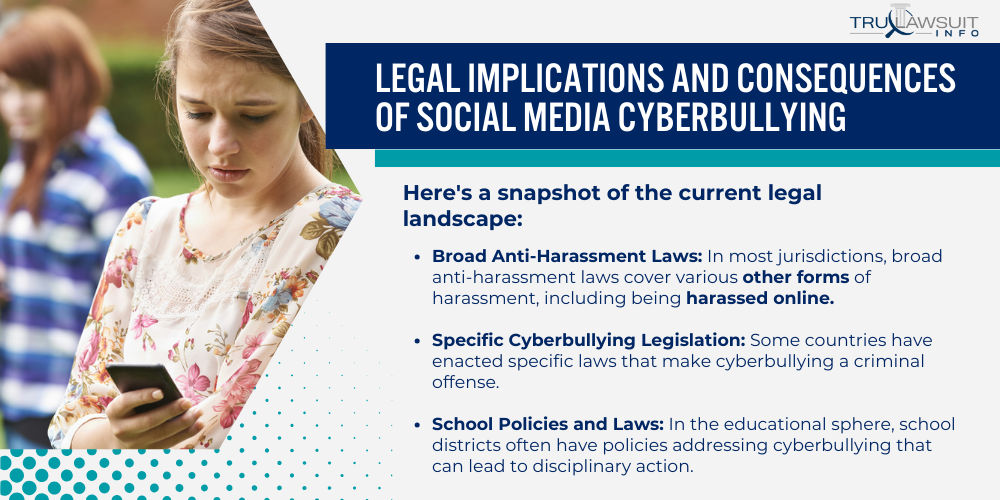
Governments and legal systems across the world have started formulating responses to this pervasive issue.
Existing Laws and Regulations Addressing Cyberbullying
Governments have recognized the pressing nature of cyberbullying and have established laws and regulations to address it.
Here’s a snapshot of the current legal landscape:
- Broad Anti-Harassment Laws: In most jurisdictions, broad anti-harassment laws cover various other forms of harassment, including being harassed online.
- Specific Cyberbullying Legislation: Some countries have enacted specific laws that make cyberbullying a criminal offense.
- School Policies and Laws: In the educational sphere, school districts often have policies addressing cyberbullying that can lead to disciplinary action.
- Civil Remedies: Beyond criminal law, victims of cyberbullying have civil remedies such as defamation suits, depending on the circumstances.
To learn more about these laws, readers might wish to explore the findings of the Pew Research Center’s study on teens and cyberbullying.
Potential Legal Recourse for Victims and Their Families
Victims of cyberbullying and their families are not without legal recourse.
The following actions may be pursued:
- Filing a Report With Law Enforcement: if cyberbullying involves threats or harassment, it can often be reported to the police.
- Seeking a Restraining Order: Victims can sometimes obtain a court order to prohibit the bully from further contact legally.
- Litigating For Damages: Families may pursue lawsuits for any emotional or reputational damages caused by cyberbullying.
- Engaging With Internet Service Providers: In certain cases, internet service providers may be involved in taking down harmful content.
- Contacting Social Media Platforms: Families can report abusive behavior directly to social media companies with policies about content removal.
For insight into navigating the legal system in response to online aggression, an article from Spatz Law Firm may provide valuable context.
Empowering Bystanders to Stand Up Against Cyberbullying
In the digital age, where cyberbullying is a pervasive issue, empowering bystanders to act can make significant strides in mitigating online abuse.
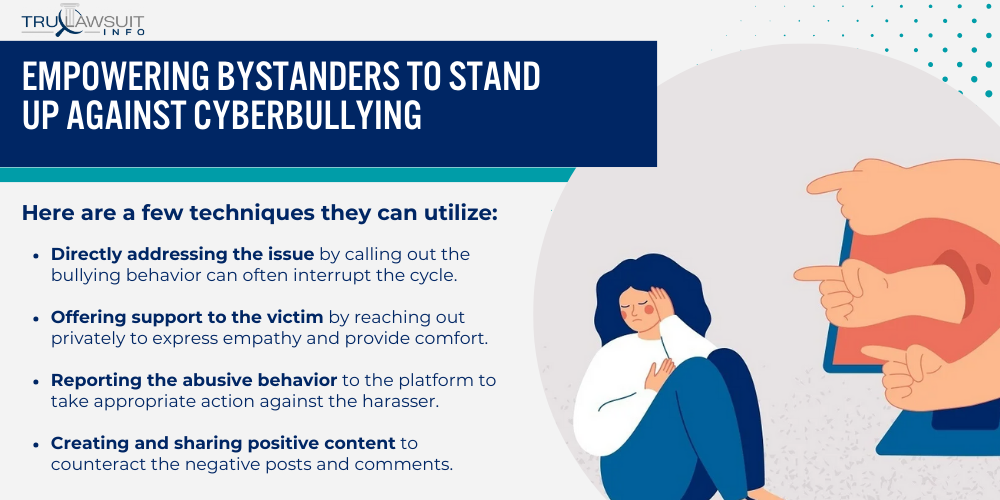
Bystanders can transform the online environment by stepping up and supporting those who are bullied.
Teaching Effective Intervention Techniques
Effective intervention is key when it comes to combating cyberbullying.
They can become a shield against the negativity and harm that can proliferate in online spaces.
Here are a few techniques they can utilize:
- Directly addressing the issue by calling out the bullying behavior can often interrupt the cycle.
- Offering support to the victim by reaching out privately to express empathy and provide comfort.
- Reporting the abusive behavior to the platform to take appropriate action against the harasser.
- Creating and sharing positive content to counteract the negative posts and comments.
Bystanders, particularly in online forums like chat rooms, hold substantial power in setting the tone for online activities.
Promoting a Culture of Kindness and Respect Online
Establishing a supportive online culture is essential to deterring cyberbullying.
A few guiding principles can lay the foundation:
- Encouraging positive communication and discouraging derogatory language related to sexual orientation or other personal traits.
- Highlighting the impact of words to remind individuals that the person behind each screen is real and that feelings get hurt just as they would with face-to-face bullying.
- Recognizing positive behavior online draws attention to users who contribute to a respectful online community.
- Education about cyberbullying’s effects, emphasizing that bullying, whether online or in person, can have lasting natural consequences on young adults and teenagers, should be widespread.
When bystanders are educated and encouraged, the instances of individuals being bullied online may be reduced.
TruLawsuit Info: #1 Social Media Cyberbullying Lawyer
Legal measures are essential when dealing with cyberbullying on social media.
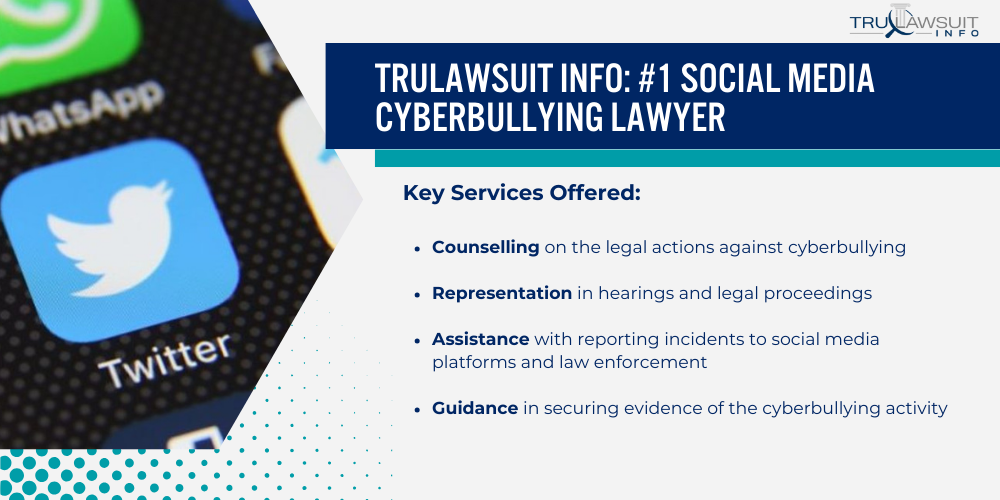
TruLawsuit, a renowned legal service, offers unparalleled expertise in social media cyberbullying cases. They provide support for victims seeking justice against online harassment and bullying.
The firm’s recognition as the top social media cyberbullying lawyer is a testimony to their dedicated approach in representing affected clients.
Key Services Offered:
- Counselling on the legal actions against cyberbullying
- Representation in hearings and legal proceedings
- Assistance with reporting incidents to social media platforms and law enforcement
- Guidance in securing evidence of the cyberbullying activity
Why Choose TruLawsuit: TruLawsuit has a notable background in social media law, offering victims of cyberbullying a strong legal foundation.
Their lawyers specialize in understanding the legal implications of online harassment and possess a track record of achieving favorable outcomes.
- Their legal team stays ahead of the evolving landscape of digital law.
- They prioritize the confidentiality and emotional well-being of their clients.
- They work closely with technology experts to trace and identify perpetrators.
- They have a reputation for diligence, securing evidence crucial for prosecution.
Feeling overwhelmed by online harassment? TruLawsuit can help! We provide resources to understand your rights when you face online harassment.
Our easy-to-navigate platform guides you through the laws and regulations protecting you, empowering you to act clearly and effectively.
Frequently Asked Questions
-
What are the most common forms of cyberbullying on social media platforms?
Cyberbullying on social media can manifest in various ways that include harassment, impersonation, spreading rumors, and creating fake profiles.
This harmful behavior often involves sending aggressive messages or posting damaging content to embarrass or intimidate individuals deliberately.
-
What steps can individuals take to protect themselves from cyberbullying?
To safeguard themselves from cyberbullying, individuals should adjust their privacy settings to restrict who can view their content and messages.
It’s also advisable to keep personal information private and to be selective about who is added as a friend or follower.
Reporting abusive content and blocking bullies can also deter further incidents.
-
How can parents monitor their children’s social media use to prevent cyberbullying?
Parents can monitor their children’s social media by holding regular discussions about online activity, reviewing privacy settings together, and utilizing parental control tools.
They should also encourage their children to speak up if they witness or become victims of cyberbullying.
-
What legal actions can be taken against cyberbullies?
Legal actions against cyberbullies can involve contacting the social media platform to report abuse and, if necessary, filing a report with the police for serious cases such as threats or harassment.
In certain jurisdictions, specific laws may address cyberbullying, which can lead to legal consequences for the perpetrator.
-
How do social media companies address cyberbullying on their platforms?
Social media companies typically address cyberbullying by providing users with features to report inappropriate behavior and block users.
Many platforms also employ moderators and algorithms to detect and remove bullying content.
They frequently update their policies to address new forms of cyberbullying.
-
What are the psychological impacts of cyberbullying on victims?
The psychological impacts of cyberbullying on victims can include increased feelings of anxiety and depression, a decrease in self-esteem, and in severe cases, suicidal thoughts.
Victims may experience a sense of isolation and fear that can affect their daily function and well-being.

Experienced Attorney & Legal SaaS CEO
With over 25 years of legal experience, Jessie is an Illinois lawyer, a CPA, and a mother of three. She spent the first decade of her career working as an international tax attorney at Deloitte.
In 2009, Jessie co-founded her own law firm with her husband – which has scaled to over 30 employees since its conception.
In 2016, Jessie founded TruLaw, which allows her to collaborate with attorneys and legal experts across the United States on a daily basis. This hypervaluable network of experts is what enables her to share reliable legal information with her readers!
Have A Case?
Here, at Tru Lawsuit Info, we’re committed to helping victims get the justice they deserve.
To do this, we actively work to connect them with attorneys who are experts in litigating cases similar to theirs.
Would you like our help?
Tru Lawsuit Info is a reliable source of information about issues that may affect your health and safety, such as faulty products, data breaches, and environmental hazards.
Our team of experienced writers collaborates with medical professionals, lawyers, and advocates to produce informative articles, guides, and other resources that raise awareness of these topics.
Our thorough research provides consumers with access to reliable information and updates on lawsuits happening around the country. We also can connect consumers with attorneys if they need assistance.
Camp Lejeune's water contamination issue spanned several decades starting in the 1950s. Exposure to these chemicals has been linked to various serious health issues, including cancer, organ diseases, and death.
Research is increasingly suggesting a link between the use of Tylenol during pregnancy and the development of neurodevelopmental disorders, such as autism and ADHD, in infants.
Legal action is being taken against manufacturers of Aqueous Film-Forming Foam (AFFF), a chemical used in fighting fires. The plaintiffs allege that exposure to the foam caused health issues such as cancer, organ damage, and birth and fertility issues.
Have A Case?
Here, at Tru Lawsuit Info, we’re committed to helping victims get the justice they deserve.
To do this, we actively work to connect them with attorneys who are experts in litigating cases similar to theirs.
Would you like our help?







